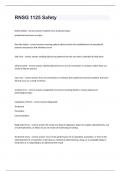Samenvatting
Summary Robot Interaction Lecture 2 + Literature
- Instelling
- Vrije Universiteit Amsterdam (VU)
In this file, I have summarised both the live lecture 2 as well as the according literature. It entails all the information required for both the assignments as well as the exam.
[Meer zien]













